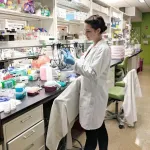(Press-News.org) Researchers from Yokohama National University in Japan have developed a prototype microprocessor using superconductor devices that are about 80 times more energy efficient than the state-of-the-art semiconductor devices found in the microprocessors of today's high-performance computing systems.
As today's technologies become more and more integrated in our daily lives, the need for more computational power is ever increasing. Because of this increase, the energy use of that increasing computational power is growing immensely. For example, so much energy is used by modern day data centers that some are built near rivers so that the flowing water can be used to cool the machinery.
"The digital communications infrastructure that supports the Information Age that we live in today currently uses approximately 10% of the global electricity. Studies suggest that in the worst case scenario, if there is no fundamental change in the underlying technology of our communications infrastructure such as the computing hardware in large data centers or the electronics that drive the communication networks, we may see its electricity usage rise to over 50% of the global electricity by 2030," says Christopher Ayala, an associate professor at Yokohama National University, and lead author of the study.
The team's research, published in Journal: IEEE Journal of Solid-State Circuits, details an effort to develop a more energy efficient microprocessor architecture using superconductors, devices that are incredibly efficient, but require certain environmental conditions to operate.
To tackle this power problem, the team explored the use of an extremely energy-efficient superconductor digital electronic structure, called the adiabatic quantum-flux-parametron (AQFP), as a building block for ultra-low-power, high-performance microprocessors, and other computing hardware for the next generation of data centers and communication networks.
"In this paper, we wanted to prove that the AQFP is capable of practical energy-efficient high-speed computing, and we did this by developing and successfully demonstrating a prototype 4-bit AQFP microprocessor called MANA (Monolithic Adiabatic iNtegration Architecture), the world's first adiabatic superconductor microprocessor," said Ayala.
"The demonstration of our prototype microprocessor shows that the AQFP is capable of all aspects of computing, namely: data processing and data storage. We also show on a separate chip that the data processing part of the microprocessor can operate up to a clock frequency of 2.5 GHz making this on par with today's computing technologies. We even expect this to increase to 5-10 GHz as we make improvements in our design methodology and our experimental setup," Ayala said.
However, superconductors require extremely cool temperatures to operate successfully. One would think that if you factor in the cooling required for a superconductor microprocessor, the energy requirement would become undesirable and surpass current day microprocessors. But according to the research team this, surprisingly, was not the case:
"The AQFP is a superconductor electronic device, which means that we need additional power to cool our chips from room temperature down to 4.2 Kelvin to allow the AQFPs to go into the superconducting state. But even when taking this cooling overhead into account, the AQFP is still about 80 times more energy-efficient when compared to the state-of-the-art semiconductor electronic devices found in high-performance computer chips available today."
Now that the team has proven the concept of this superconductor chip architecture, they plan to optimize the chip and determine the chip's scalability and speed post optimization.
"We are now working towards making improvements in the technology, including the development of more compact AQFP devices, increasing the operation speed, and increasing the energy-efficiency even further through reversible computation," Ayala said. "We are also scaling our design approach so that we can fit as many devices as possible in a single chip and operate all of them reliably at high clock frequencies."
In addition to building standard microprocessors, the team is also interested in examining how AQFPs could assist in other computing applications such as neuromorphic computing hardware for artificial intelligence as well as quantum computing applications.
INFORMATION:
Yokohama National University (YNU or Yokokoku) is a Japanese national university founded in 1949. YNU provides students with a practical education utilizing the wide expertise of its faculty and facilitates engagement with the global community. YNU's strength in the academic research of practical application sciences leads to high-impact publications and contributes to international scientific research and the global society. For more information, please see: https://www.ynu.ac.jp/english/
COLUMBUS, Ohio - A single positive experience on a psychedelic drug may help reduce stress, depression and anxiety symptoms in Black, Indigenous and people of color whose encounters with racism have had lasting harm, a new study suggests.
The participants in the retrospective study reported that their trauma-related symptoms linked to racist acts were lowered in the 30 days after an experience with either psilocybin (Magic Mushrooms), LSD or MDMA (Ecstasy).
"Their experience with psychedelic drugs was so powerful that they could recall and report on changes in symptoms from racial trauma that they had experienced in their lives, and they ...
Cancer cells are known for spreading genetic chaos. As cancer cells divide, DNA segments and even whole chromosomes can be duplicated, mutated, or lost altogether. This is called chromosomal instability, and scientists at Memorial Sloan Kettering have learned that it is associated with cancer's aggressiveness. The more unstable chromosomes are, the more likely that bits of DNA from these chromosomes will end up where they don't belong: outside of a cell's central nucleus and floating in the cytoplasm.
Cells interpret these rogue bits of DNA as evidence ...
BOSTON - Some police departments in the United States continue to teach officers that neck restraints are a safe method for controlling agitated or aggressive people, but that's a dangerous myth, according to a Viewpoint written by three neurologists at Massachusetts General Hospital (MGH) in JAMA Neurology.
The killing of George Floyd, a Black man who died while being arrested in May 2020 after a police officer pressed a knee to his neck for more than eight minutes, helped spark a national conversation about racial ...
Certain bacteria, known as plant-growth-promoting bacteria (PGPB), can improve plant health or protect them from pathogens and are used commercially to help crops. To further improve agricultural yields, it is helpful to identify factors that can improve PGPB behavior.
Many PGPB form sticky communities of cells, known as biofilms, that help them adhere to plant roots. A group of scientists in North Carolina and Massachusetts were interested in finding other plant-associated bacteria that could help PGPB better adhere to plant roots, with the hope that increasing the number of PGPB cells attached to roots would increase their beneficial activities. ...
Scripps Institution of Oceanography at UC San Diego researchers have uncovered how rain and waves act on different parts of coastal cliffs.
Following three years of cliff surveys in and near the coastal city of Del Mar, Calif., they determined that wave impacts directly affect the base, and rain mostly impacts the upper region of the cliffs.
The study appears in the journal Geomorphology and was funded by California State Parks. California's State Parks Oceanography program supports climate adaptation and resilience efforts through coastal and cliff erosion observations and modeling, ...
Below please find a summary and link(s) of new coronavirus-related content published today in Annals of Internal Medicine. The summary below is not intended to substitute for the full article as a source of information. A collection of coronavirus-related content is free to the public at http://go.annals.org/coronavirus.
1. Review concludes universal mask use by lay persons reduces the spread of viral infections including SARS-CoV-2
Findings affirm policy promised by President-Elect Biden, who will ...
What The Study Did: This study identified racial/ ethnic, sex, age, language, and socioeconomic differences in accessing telemedicine for primary care and specialty ambulatory care; if not addressed, these differences may compound existing inequities in care among vulnerable populations.
Authors: Srinath Adusumalli, M.D., M.Sc., of the Hospital of the University of Pennsylvania in Philadelphia, is the corresponding author.
To access the embargoed study: Visit our For The Media website ...
What The Study Did: Severe COVID-19 is characterized by the intense formation of neutrophil extracellular traps (NETs), leading to the blockage of microvessels, as shown in pulmonary samples. The occurrence of ST-elevated myocardial infarction (STEMI) is a serious cardiac manifestation of COVID-19; the intrinsic mechanism of coronary thrombosis appears to still be unknown. This case series report of five patients sought to determine the role of NETs in coronary thrombosis in patients with COVID-19.
Authors: Ana Blasco, M.D., Ph.D., of the Hospital Universitario Puerta de Hierro-Majadahonda in Madrid, Spain, is the corresponding ...
In 1986, cellular biochemist Kazumitsu Ueda, currently at Kyoto University's Institute for Integrated Cell-Material Sciences (iCeMS), discovered that a protein called ABCB1 could transport multiple chemotherapeutics out of some cancer cells, making them resistant to treatment. How it did this has remained a mystery for the past 35 years. Now, his team has published a review in the journal FEBS Letters, summarizing what they have learned following years of research on this and other ATP-binding cassette (ABC) transporter proteins.
ABC transporter proteins are very similar across species and have various ...
Scientists have suspected mutations in a cellular cholesterol transport protein are associated with psychiatric disorders, but have found it difficult to prove this and to pinpoint how it happens. Now, Kazumitsu Ueda of Kyoto University's Institute for Integrated Cell-Material Sciences (iCeMS) and colleagues in Japan have provided evidence that mice with disrupted ABCA13 protein demonstrate a hallmark behaviour of schizophrenia. The team investigated ABCA13's functions and published their findings in the Journal of Biological Chemistry.
ABCA13 belongs to a family of cellular transporter proteins called ATP-binding ...



